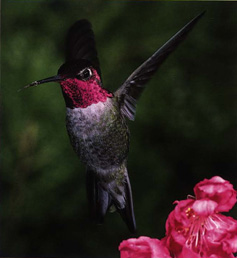
Hover Flight
Hummingbirds can hover better than any other birds because of the unusual structure of their wings. Other birds have wings with several movable joints. Hummingbird wings are different. The bones in their wings are permanently fixed and rigid, except at the shoulder joint, where the wing can move freely in all directions.
When hovering, a hummingbird's wing moves forward, and then the leading edge rotates nearly 180 degrees and moves back again. During this movement the tips of the wings trace a horizontal figure eight in the air.
Living Jewels
Iridescent hummingbird feathers are the most specialized of all bird feathers. On a humming bird's brilliant gorget, or throat patch, only the outer third of each feather is iridescent. This part of the feather contains layers of minute structures called platelets that are filled with tiny air bubbles. These structures partially reflect back light, causing the brilliant shining colors of reds, purples, and blues seen on hummingbirds.

A male Anna's hummingbird with its tongue partly out and pollen on its bill.

Figure-eight pattern of hummingbird's wings while the bird hovers.
The iridescent parts of the feathers of the gorget are flat, and so reflect light in just one direction. Therefore, in order for you to see the iridescence of the gorget, the sun must be striking the feathers in just the right way. If not, then they will look dusky or even black.
The back feathers of hummingbirds also have iridescence, but the iridescent parts of the feathers are concave and reflect light from any direction.
Torpor
To conserve energy at night, hummingbirds sometimes go into a state of torpor. Their heartbeat slows to about 50 beats per minute and their breathing becomes irregular with some periods during which they do not breathe at all. Hummingbirds do not go into torpor every night, only when their energy reserves are so low that they have to resort to this method of energy conservation.

A rare albino ruby-throated hummingbird.
Torpor can last from 8 to 14 hours. The next morning, arousing from torpor can take up to one hour for the larger hummingbirds. As they wake up, their heartbeat and breathing rates increase. When their body temperature reaches 86 degrees Fahrenheit, they can fly again.
Hitchhikers
There is an incredible connection between flowers, hummingbirds, and minute species of mites. In many flowers there are mites that grow and reproduce within the blossoms, feeding on nectar and pollen. When the flower stops blooming and no longer contains nectar r pollen then the mites have to move on. One way that they do this is by catching a ride with hummingbird.
As the bird visits the flower to sip nectar, the mites run onto the bird's bill and into its nostrils. (This does not hurt the hummingbird.) They wait there until the bird visits another flower of the same species as the one that they left, and then they get off.
Each species of mite tends to specialize in just one flower type, possibly to enhance its chances of finding other mites of its species with which to mate. Although there are many kinds of hummingbird flower mites in the tropics, only one species has been found in the United States and it lives along the coast of California on the paintbrush flower (Castilleja spp.).
During the winter the mites are usually carried south into Mexico by the hummingbirds. Some have been found to spend the winter in California in introduced species of aloe plants. However, the mites’ main home is in paintbrush flowers, and there is little worry of their being spread to other garden flowers by the hummingbirds.
Albino Hummingbirds
Albino hummingbirds are very rare. Albinism is caused by a genetic change that prevents the formation of dark-colored pigment in feathers. There are different degrees of albinism. Birds may have partial albinism, in which just some feathers are white, or in the rarest forms may have a total absence of pigment from skin, feathers, and eyes. Albino birds don't live long because they often have poor eyesight and brittle feathers and thus reduced flying ability.